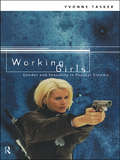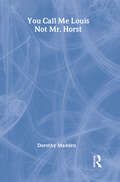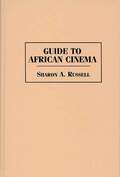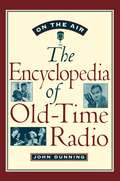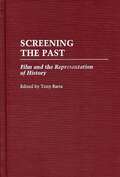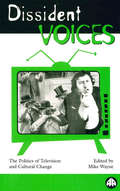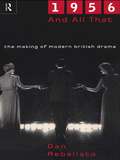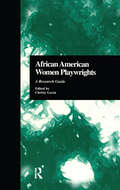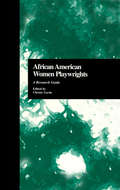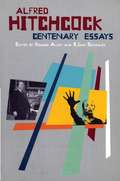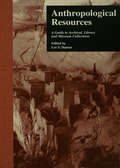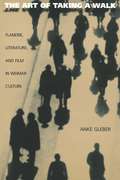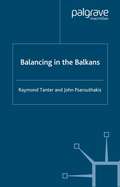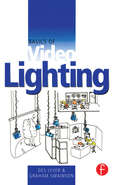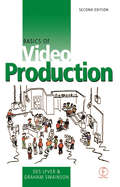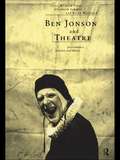- Table View
- List View
Working Girls: Gender and Sexuality in Popular Cinema
by Yvonne TaskerWorking Girls investigates the thematic concerns of contemporary Hollywood cinema, and its ambivalent articulation of women as both active, and defined by sexual performance, asking whether new Hollywood cinema has responded to feminism and contemporary sexual identities. Whether analysing the rise of films centred around female friendships, or the entrance of pop stars such as Whitney Houston and Madonna into film, Working Girls is an authoritative investigation of the presence of women both as film makers and actors in contemporary mainstream cinema.
Working Girls: Gender and Sexuality in Popular Cinema
by Yvonne TaskerWorking Girls investigates the thematic concerns of contemporary Hollywood cinema, and its ambivalent articulation of women as both active, and defined by sexual performance, asking whether new Hollywood cinema has responded to feminism and contemporary sexual identities. Whether analysing the rise of films centred around female friendships, or the entrance of pop stars such as Whitney Houston and Madonna into film, Working Girls is an authoritative investigation of the presence of women both as film makers and actors in contemporary mainstream cinema.
You Call Me Louis, Not Mr. Horst
by Dorothy MaddenDorothy Madden's lively book about Louis Horst (You don't call me Mr. Horst, you call me Louis, he always said) makes for compulsive reading. She follows Horst's extraordinary life, punctuating her narrative with reminiscences, illuminating anecdotes from her personal store of memories, as well as the shared thoughts of others, all interspersed with her choice of evocative and expressive photographs and illustrations, to create a dynamic and memorable portrait of this key figure in American modern dance. Louis Horst: musician, composer, pianist, violonist, pit player, arranger, super accompanist (all sorts), conductor, régisseur, stage manager, tour tartar, catalyst, editor, writer, critic, teacher, consoler, the Sherlock Holmes of restaurants, keeper of journals and budgets, loan provider, lover, friend...
You Call Me Louis, Not Mr. Horst
by Dorothy MaddenDorothy Madden's lively book about Louis Horst (You don't call me Mr. Horst, you call me Louis, he always said) makes for compulsive reading. She follows Horst's extraordinary life, punctuating her narrative with reminiscences, illuminating anecdotes from her personal store of memories, as well as the shared thoughts of others, all interspersed with her choice of evocative and expressive photographs and illustrations, to create a dynamic and memorable portrait of this key figure in American modern dance. Louis Horst: musician, composer, pianist, violonist, pit player, arranger, super accompanist (all sorts), conductor, régisseur, stage manager, tour tartar, catalyst, editor, writer, critic, teacher, consoler, the Sherlock Holmes of restaurants, keeper of journals and budgets, loan provider, lover, friend...
Guide to African Cinema (Reference Guides to the World's Cinema)
by Sharon A. RussellIntended as a guide to the filmmakers and films of the African cinema, this reference book also provides the framework for understanding the history and development of African film with respect to its situation in world cinema. The goals and achievements of African film are studied with respect to the forces that impact it, such as colonialism and racism. The importance of the creative efforts of African filmmakers and the diversity of their approaches to cinema are explored. Examined as well are the views of Africa presented by European colonial filmmakers, views often contested in contemporary African film. The listings include critical analysis, bio-bibliography, and filmographies. Both Saharan and sub-Saharan films are included.As an important reference to African film, the information outlined is valuable due to the current lack of researched data on African cinema, in part as a result of postcolonial attitudes on production and distribution. The book concentrates on films and directors who work toward defining a unique, African perspective without compromising thematic concerns due to commercial considerations. The research detailed in this text should encourage a wider appreciation of the film work being done in Africa, especially to those without the benefit of access to specialized libraries and collections.
On the Air: The Encyclopedia of Old-Time Radio
by John DunningNow long out of print, John Dunning's Tune in Yesterday was the definitive one-volume reference on old-time radio broadcasting. Now, in On the Air, Dunning has completely rethought this classic work, reorganizing the material and doubling its coverage, to provide a richer and more informative account of radio's golden age. Here are some 1,500 radio shows presented in alphabetical order. The great programs of the '30s, '40s, and '50s are all here--Amos 'n' Andy, Fibber McGee and Molly, The Lone Ranger, Major Bowes' Original Amateur Hour, and The March of Time, to name only a few. For each, Dunning provides a complete broadcast history, with the timeslot, the network, and the name of the show's advertisers. He also lists major cast members, announcers, producers, directors, writers, and sound effects people--even the show's theme song. There are also umbrella entries, such as "News Broadcasts," which features an engaging essay on radio news, with capsule biographies of major broadcasters, such as Lowell Thomas and Edward R. Murrow. Equally important, Dunning provides a fascinating account of each program, taking us behind the scenes to capture the feel of the performance, such as the ghastly sounds of Lights Out (a horror drama where heads rolled and bones crunched), and providing engrossing biographies of the main people involved in the show. A wonderful read for everyone who loves old-time radio, On the Air is a must purchase for all radio hobbyists and anyone interested in 20th-century American history. It is an essential reference work for libraries and radio stations.
Screening the Past: Film and the Representation of History
Film and television have been accepted as having a pervasive influence on how people understand the world. An important aspect of this is the relationship of history and film. The different views of the past created by film, television, and video are only now attracting closer attention from historians, cultural critics, and filmmakers. This volume seeks to advance the critical exploration scholars have recently begun.Barta begins by addressing the various ways the past is screened for our understanding and relates the art of film to other media. The essays that follow deal primarily with the changing perspectives of political and social developments—and changing concepts of ideology, gender, or culture—in films and television programs made for historically shaped reasons. Chapters by filmmakers explore issues of context and intent in their own projects. Scholars and general readers interested in film and cultural studies will find this an important volume.
Dissident Voices: The Politics of Television and Cultural Change
by Mike Wayne‘Wayne’s study offers an impressive range of readings and critical methodologies within a collection of exceptional coherence... Dissident Voices is consistently compulsive reading and a must for all students and specialists in the field of recent and contemporary television culture.’ Professor Madeleine MacMurraugh-Kavanagh, University of Reading Two decades of institutional and structural changes in television broadcasting have both informed and reflected profound shifts in British culture. How have programme makers themselves approached the tensions and anxieties of the last twenty years? Dissident Voices examines the ways in which certain forms and genres have registered a period of cultural upheaval and to what extent they have developed a more reflexive and a more critical television culture. This collection covers a broad range of issues including class, gender and sexuality, the monarchy, identity and nationhood. It examines their representation in a variety of dramas and genres, including police procedurals, documentaries, game shows, sitcoms and satire. The contributors challenge the notion of television as a bland purveyor of the status quo, presenting it as a complex and potentially subversive medium. Television culture is portrayed here as still resistant to the total control of either markets or ideologies. In an age of political consensus, it is an important and popular site where anxiety about and dissent from current social trends frequently surface.
1956 and All That: The Making of Modern British Drama
by Dan RebellatoIt is said that British Drama was shockingly lifted out of the doldrums by the 'revolutionary' appearance of John Osborne's Look Back in Anger at the Royal Court in May 1956. But had the theatre been as ephemeral and effeminate as the Angry Young Men claimed? Was the era of Terence Rattigan and 'Binkie' Beaumont as repressed and closeted as it seems? In this bold and fascinating challenge to the received wisdom of the last forty years of theatrical history, Dan Rebellato uncovers a different story altogether. It is one where Britain's declining Empire and increasing panic over the 'problem' of homosexuality played a crucial role in the construction of an enduring myth of the theatre. By going back to primary sources and rigorously questioning all assumptions, Rebellato has rewritten the history of the Making of Modern British Drama.
1956 and All That: The Making of Modern British Drama
by Dan RebellatoIt is said that British Drama was shockingly lifted out of the doldrums by the 'revolutionary' appearance of John Osborne's Look Back in Anger at the Royal Court in May 1956. But had the theatre been as ephemeral and effeminate as the Angry Young Men claimed? Was the era of Terence Rattigan and 'Binkie' Beaumont as repressed and closeted as it seems? In this bold and fascinating challenge to the received wisdom of the last forty years of theatrical history, Dan Rebellato uncovers a different story altogether. It is one where Britain's declining Empire and increasing panic over the 'problem' of homosexuality played a crucial role in the construction of an enduring myth of the theatre. By going back to primary sources and rigorously questioning all assumptions, Rebellato has rewritten the history of the Making of Modern British Drama.
African American Women Playwrights: A Research Guide (Critical Studies in Black Life and Culture #31)
by Christy GavinFirst Published in 1999. Routledge is an imprint of Taylor & Francis, an informa company.
African American Women Playwrights: A Research Guide (Critical Studies in Black Life and Culture)
by Christy GavinFirst Published in 1999. Routledge is an imprint of Taylor & Francis, an informa company.
Alfred Hitchcock: Centenary Essays
by Richard Allen S. Ishii-GonzalèsThis collection of essays displays the range and breadth of Hitchcock scholarship and assesses the significance of his body of work as a bridge between the fin de siecle culture of the 19th century and the 20th century. It engages with Hitchcock's characteristic formal and aesthetic preoccupations.
The Analysis of Performance Art: A Guide to its Theory and Practice
by Anthony Howell A. HowellThis finely illustrated book offers a simple yet comprehensive 'grammar' of a new discipline. Performance Art first became popular in the fifties when artists began creating 'happenings'. Since then the artist as a performer has challenged many of the accepted rules of the theatre and radically altered our notion of what constitutes visual art. This is the first publication to outline the essential characteristics of the field and to put forward a method for teaching the subject as a discipline distinct from dance, drama, painting or sculpture.Taking the theory of primary and secondary colours as his model, Anthony Howell posits three primaries of action and shows how these may be mixed to obtain a secondary range of actions. Based on a taught course, the system is designed for practical use in the studio and is also entertaining to explore. Examples are cited from leading performance groups and practitioners such as Bobbie Baker, Orlan, Stelarc, Annie Sprinkle, Robert Wilson, Goat Island, and Station House Opera. This volume, however, is not just an illustrated grammar of action - it also shows how the syntax of that grammar has psychoanalytic repercussions. This enables the performer to relate the system to lived experience, ensuring a realisation that meaning is being dealt with through these actions and that the stystem set forth is more than a dry structuring of the characteristics of movement.Freud's notion of 'transference' and Lacan's understanding of 'repetition' are compared to a performer's usage of the same terms. Thus the book provides a psychoanalytic critique of performance at the same time as it outlines an efficient method for creating live work on both fine art and theatre courses.
The Analysis of Performance Art: A Guide to its Theory and Practice
by Anthony Howell A. HowellThis finely illustrated book offers a simple yet comprehensive 'grammar' of a new discipline. Performance Art first became popular in the fifties when artists began creating 'happenings'. Since then the artist as a performer has challenged many of the accepted rules of the theatre and radically altered our notion of what constitutes visual art. This is the first publication to outline the essential characteristics of the field and to put forward a method for teaching the subject as a discipline distinct from dance, drama, painting or sculpture.Taking the theory of primary and secondary colours as his model, Anthony Howell posits three primaries of action and shows how these may be mixed to obtain a secondary range of actions. Based on a taught course, the system is designed for practical use in the studio and is also entertaining to explore. Examples are cited from leading performance groups and practitioners such as Bobbie Baker, Orlan, Stelarc, Annie Sprinkle, Robert Wilson, Goat Island, and Station House Opera. This volume, however, is not just an illustrated grammar of action - it also shows how the syntax of that grammar has psychoanalytic repercussions. This enables the performer to relate the system to lived experience, ensuring a realisation that meaning is being dealt with through these actions and that the stystem set forth is more than a dry structuring of the characteristics of movement.Freud's notion of 'transference' and Lacan's understanding of 'repetition' are compared to a performer's usage of the same terms. Thus the book provides a psychoanalytic critique of performance at the same time as it outlines an efficient method for creating live work on both fine art and theatre courses.
Anthropological Resources: A Guide to Archival, Library, and Museum Collections (Sociology/Psychology/Reference)
by Lee S. Dutton Michele Calhoun Francis X. Grollig S. J. Thomas L. Mann Hans E. Panofsky Margo L. Smith Sol Tax Christopher WintersFirst published in 1999. Routledge is an imprint of Taylor & Francis, an informa company.
Anthropological Resources: A Guide to Archival, Library, and Museum Collections (Sociology/Psychology/Reference)
by Lee S. DuttonFirst published in 1999. Routledge is an imprint of Taylor & Francis, an informa company.
The Art of Taking a Walk: Flanerie, Literature, and Film in Weimar Culture
by Anke GleberAnke Gleber examines one of the most intriguing and characteristic figures of European urban modernity: the observing city stroller, or flaneur. In an age transformed by industrialism, the flaneur drifted through city streets, inspired and repelled by the surrounding scenes of splendor and squalor. Gleber examines this often elusive figure in the particular contexts of Weimar Germany and the intellectual sphere of Walter Benjamin, with whom the concept of flanerie is often associated. She sketches the European influences that produced the German flaneur and establishes the figure as a pervasive presence in Weimar culture, as well as a profound influence on modern perceptions of public space. The book begins by exploring the theory of literary flanerie and the technological changes--street lighting, public transportation, and the emergence of film--that gave a new status to the activities of seeing and walking in the modern city. Gleber then assesses the place of flanerie in works by Benjamin, Siegfried Kracauer, and other representatives of Weimar literature, arts, and theory. She draws particular attention to the works of Franz Hessel, a Berlin flaneur who argued that flanerie is a "reading" of the city that perceives passersby, streets, and fleeting impressions as the transitory signs of modernity. Gleber also examines connections between flanerie and Weimar film, and discusses female flanerie as a means of asserting female subjectivity in the public realm. The book is a deeply original and searching reassessment of the complex intersections among modernity, vision, and public space.
The Art of Taking a Walk: Flanerie, Literature, and Film in Weimar Culture
by Anke GleberAnke Gleber examines one of the most intriguing and characteristic figures of European urban modernity: the observing city stroller, or flaneur. In an age transformed by industrialism, the flaneur drifted through city streets, inspired and repelled by the surrounding scenes of splendor and squalor. Gleber examines this often elusive figure in the particular contexts of Weimar Germany and the intellectual sphere of Walter Benjamin, with whom the concept of flanerie is often associated. She sketches the European influences that produced the German flaneur and establishes the figure as a pervasive presence in Weimar culture, as well as a profound influence on modern perceptions of public space. The book begins by exploring the theory of literary flanerie and the technological changes--street lighting, public transportation, and the emergence of film--that gave a new status to the activities of seeing and walking in the modern city. Gleber then assesses the place of flanerie in works by Benjamin, Siegfried Kracauer, and other representatives of Weimar literature, arts, and theory. She draws particular attention to the works of Franz Hessel, a Berlin flaneur who argued that flanerie is a "reading" of the city that perceives passersby, streets, and fleeting impressions as the transitory signs of modernity. Gleber also examines connections between flanerie and Weimar film, and discusses female flanerie as a means of asserting female subjectivity in the public realm. The book is a deeply original and searching reassessment of the complex intersections among modernity, vision, and public space.
Balancing in the Balkans
by R. Tanter J. PsarouthakisBalancing in the Balkans explores the region for ideas concerning globalism, the creation of transnational economic communities from capital flows across political boundaries, tribalism, and the disintegration of nations into ethnic factions based upon ancient hatreds. In this book, Tanter and Psarouthakis debate the best way to achieve 'balance' - how parties in conflict can learn moderation and peaceful coexistence.
Basics of Video Lighting
by Des Lyver Graham SwainsonNow fully updated by Des Lyver to reflect the latest advances, the second edition of Basics of Video Lighting is a primer for anyone wishing to learn about lighting a video production. It describes the principles and processes involved in obtaining professional results in educational, training and corporate environments. Assuming little prior knowledge, this book covers everything from the different types of lights and their control, to basic studio and location settings. It features:· the latest technology, including the use of location and grip gear and changes in lamp and reflector technology · coverage of studio and location work· descriptions of the role of each crew member · full explanations of technical terms· health and safety precautions· practical advice on the equipment available and how to use itBasics of Video Lighting aims to provide the reader with a rapid understanding of what is actually a complex process, without getting too bogged down in technical terms. It is equipment non-specific and references to technical matters are only included where necessary to understanding, for example a short explanation of the simple electricity that is needed to understand the relationship between the camera and the lights.
Basics of Video Lighting
by Des Lyver Graham SwainsonNow fully updated by Des Lyver to reflect the latest advances, the second edition of Basics of Video Lighting is a primer for anyone wishing to learn about lighting a video production. It describes the principles and processes involved in obtaining professional results in educational, training and corporate environments. Assuming little prior knowledge, this book covers everything from the different types of lights and their control, to basic studio and location settings. It features:· the latest technology, including the use of location and grip gear and changes in lamp and reflector technology · coverage of studio and location work· descriptions of the role of each crew member · full explanations of technical terms· health and safety precautions· practical advice on the equipment available and how to use itBasics of Video Lighting aims to provide the reader with a rapid understanding of what is actually a complex process, without getting too bogged down in technical terms. It is equipment non-specific and references to technical matters are only included where necessary to understanding, for example a short explanation of the simple electricity that is needed to understand the relationship between the camera and the lights.
Basics of Video Production
by Des Lyver Graham SwainsonNow fully updated by Des Lyver to reflect the latest advances, the second edition of Basics of Video Production is a primer for anyone wishing to learn about video production. It describes the principles and processes involved in obtaining professional results in educational, training and corporate environments. Assuming little prior knowledge, this book takes the reader on a guided tour around a studio or location production, examining the production process from conceptualisation to the final screening. It features:· the latest advances in low cost non-linear editing and digital video· coverage of studio and location work· descriptions of the role of each crew member · full explanations of technical terms· health and safety precautions· practical advice on the equipment available and how to use itBasics of Video Production aims to provide the reader with a rapid understanding of what is actually a complex process, without getting too bogged down in technical terms. It is equipment non-specific and references to technical matters are only included where necessary to understanding. Much of what is contained in this book will be directly transferable to film and sound courses as the basics and principles are the same.
Basics of Video Production (Basics Of Ser.)
by Des Lyver Graham SwainsonNow fully updated by Des Lyver to reflect the latest advances, the second edition of Basics of Video Production is a primer for anyone wishing to learn about video production. It describes the principles and processes involved in obtaining professional results in educational, training and corporate environments. Assuming little prior knowledge, this book takes the reader on a guided tour around a studio or location production, examining the production process from conceptualisation to the final screening. It features:· the latest advances in low cost non-linear editing and digital video· coverage of studio and location work· descriptions of the role of each crew member · full explanations of technical terms· health and safety precautions· practical advice on the equipment available and how to use itBasics of Video Production aims to provide the reader with a rapid understanding of what is actually a complex process, without getting too bogged down in technical terms. It is equipment non-specific and references to technical matters are only included where necessary to understanding. Much of what is contained in this book will be directly transferable to film and sound courses as the basics and principles are the same.
Ben Jonson and Theatre: Performance, Practice and Theory
by Richard Cave Elizabeth Schafer Brian WoollandBen Jonson and Theatre is an investigation and celebration of Jonson's plays from the point of view of the theatre practitioner as well as the teacher. Reflecting the increasing interest in the wider field of Renaissance drama, this book bridges the theory/practice divide by debating how Jonson's drama operates in performance. Ben Jonson and Theatre includes: * discussions with and between practitioners * essays on the staging of the plays * edited transcripts of interviews with contemporary practitioners The volume includes contributions from Joan Littlewood, Sam Mendes, John Nettles, Simon Russell Beale and Geoffrey Rush, Oscar-winning actor for Shine.
